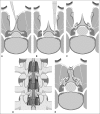Expansive Suspension Laminoplasty Using a Spinous Process-Splitting Approach for Lumbar Spinal Stenosis: Surgical Technique and Outcomes Over 8 Years of Follow-up
- PMID: 30656246
- PMCID: PMC6324890
- DOI: 10.5435/JAAOSGlobal-D-18-00008
Expansive Suspension Laminoplasty Using a Spinous Process-Splitting Approach for Lumbar Spinal Stenosis: Surgical Technique and Outcomes Over 8 Years of Follow-up
Abstract
Introduction: To maximize the benefits of posterior decompression for severe multilevel lumbar spinal stenosis, we refined the expansive laminoplasty technique using a spinous process-splitting approach. This study tests the hypothesis that the surgical benefit of adequate decompression with posterior element preservation is maintained in the long term, over 8 years of follow-up.
Methods: Fifty-eight patients were followed up yearly for 8 years. Eight patients having nonlumbar spine surgery or Parkinson disease were excluded. The noninferiority of the 8-year versus peak-year outcomes was tested, with margins of 5 points for the Oswestry disability index and 1 point for the numeric rating scales (NRSs).
Results: In the 50 patients available for follow-up, the peak values of the mean improvements from baseline within the first 7 years were 35.8, 5.7, 5.9, and 2.8 points for the Oswestry disability index, low back pain NRS, leg pain NRS, and leg numbness NRS, respectively. The 95% lower confidence limits for the differences between the mean improvements from baseline at 8 years and the peak year were within the noninferiority margins for each scale.
Conclusion: Our technique was associated with substantial improvement from baseline for each scale. The initial improvements in function and symptoms were maintained for 8 years.
Figures



Similar articles
-
Impact of Spinous Process Integrity on Ten to Twelve-Year Outcomes After Posterior Decompression for Lumbar Spinal Stenosis: Study of Open-Door Laminoplasty Using a Spinous Process-Splitting Approach.J Bone Joint Surg Am. 2015 Oct 21;97(20):1667-77. doi: 10.2106/JBJS.N.01370. J Bone Joint Surg Am. 2015. PMID: 26491131
-
Lumbar Spinous Process-Splitting Laminoplasty: A Novel Technique for Minimally Invasive Lumbar Decompression.Orthopedics. 2016 Sep 1;39(5):e950-6. doi: 10.3928/01477447-20160616-03. Epub 2016 Jun 24. Orthopedics. 2016. PMID: 27337665
-
A novel lumbar total joint replacement may be an improvement over fusion for degenerative lumbar conditions: a comparative analysis of patient-reported outcomes at one year.Spine J. 2021 May;21(5):829-840. doi: 10.1016/j.spinee.2020.12.001. Epub 2020 Dec 17. Spine J. 2021. PMID: 33346156
-
Does surgical technique influence clinical outcome after lumbar spinal stenosis decompression? A comparative effectiveness study from the Norwegian Registry for Spine Surgery.Eur Spine J. 2017 Feb;26(2):420-427. doi: 10.1007/s00586-016-4643-9. Epub 2016 Jun 4. Eur Spine J. 2017. PMID: 27262561
-
Efficacy and Safety of Full-endoscopic Decompression via Interlaminar Approach for Central or Lateral Recess Spinal Stenosis of the Lumbar Spine: A Meta-analysis.Spine (Phila Pa 1976). 2018 Dec 15;43(24):1756-1764. doi: 10.1097/BRS.0000000000002708. Spine (Phila Pa 1976). 2018. PMID: 29794584 Review.
Cited by
-
A new surgery choice of bilateral laminoplasty for symptomatic three or more-level lumbar canal stenosis in patients over 60 years old: a two-year retrospective study.BMC Musculoskelet Disord. 2025 Jul 14;26(1):680. doi: 10.1186/s12891-025-08940-1. BMC Musculoskelet Disord. 2025. PMID: 40660157 Free PMC article.
-
Endoscopic modified total laminoplasty for symptomatic lumbar spinal stenosis.J Spinal Cord Med. 2022 Jan;45(1):58-64. doi: 10.1080/10790268.2020.1762827. Epub 2020 Jun 4. J Spinal Cord Med. 2022. PMID: 32496889 Free PMC article.
References
-
- Postacchini F, Cinotti G, Perugia D, Gumina S: The surgical treatment of central lumbar stenosis: Multiple laminotomy compared with total laminectomy. J Bone Joint Surg Br 1993;75:386-392. - PubMed
-
- Kakiuchi M, Fukushima W: Impact of spinous process integrity on ten to twelve-year outcomes after posterior decompression for lumbar spinal stenosis: Study of open-door laminoplasty using a spinous process-splitting approach. J Bone Joint Surg Am 2015;97:1667-1677. - PubMed
-
- Kawaguchi Y, Kanamori M, Ishihara H, et al. : Clinical and radiographic results of expansive lumbar laminoplasty in patients with spinal stenosis. J Bone Joint Surg Am 2004;86:1698-1703. - PubMed
-
- Watanabe K, Matsumoto M, Ikegami T, et al. : Reduced postoperative wound pain after lumbar spinous process-splitting laminectomy for lumbar canal stenosis: A randomized controlled study. J Neurosurg Spine 2011;14:51-58. - PubMed
LinkOut - more resources
Full Text Sources

